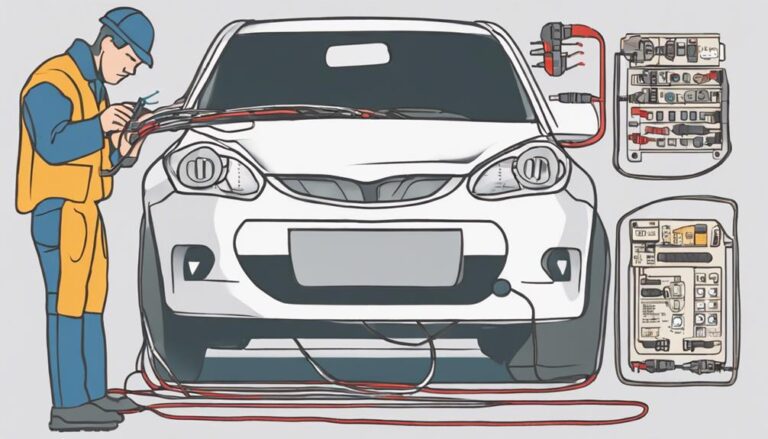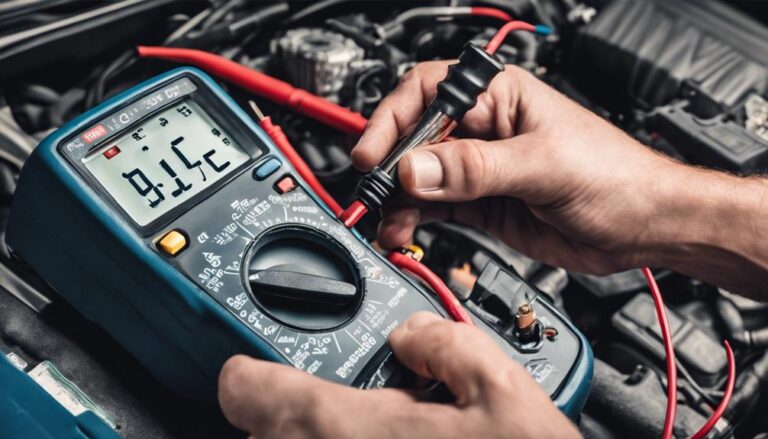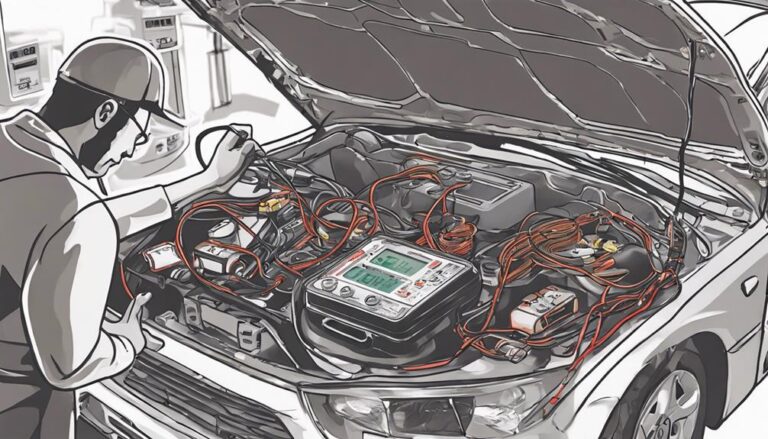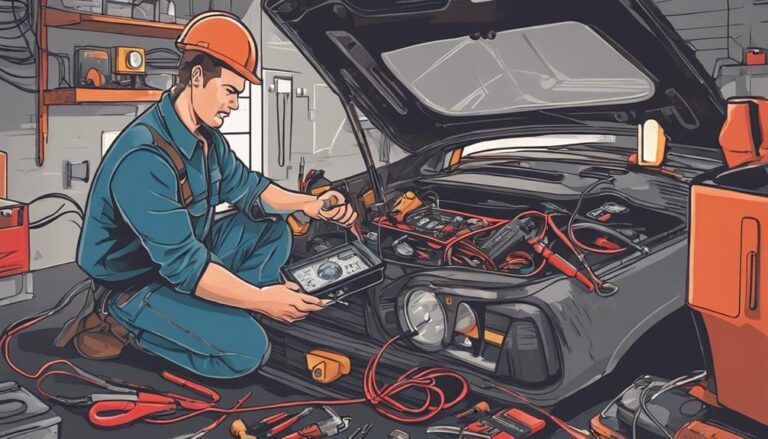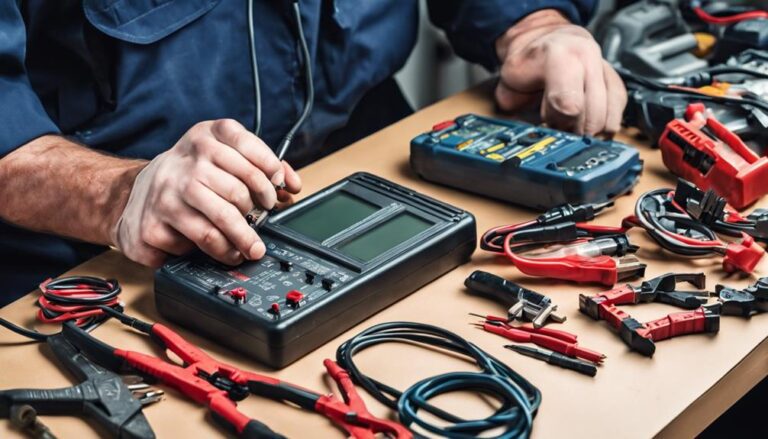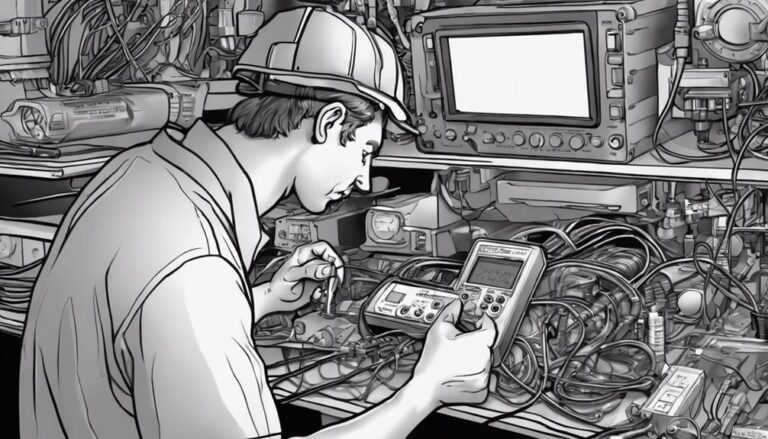Mastering Car Electrical Problems: 10 Expert Tips
If you think car electrical problems are a maze of confusion, fear not. With 10 expert tips at your disposal, navigating through the intricate world of vehicle electronics can become surprisingly manageable.
Imagine unraveling the mysteries behind flickering lights, mysterious drain on your battery, or that frustratingly intermittent starting issue. Stay tuned to uncover practical insights that could save you time, money, and needless stress on your automotive journey.
Key Takeaways
- Regularly inspect wiring to prevent hazards and ensure proper function.
- Test, identify, and replace blown fuses promptly for system integrity.
- Master battery maintenance for optimal performance and longevity.
- Conduct advanced troubleshooting for starter, ignition, and grounding issues effectively.
Understanding Car Electrical System Basics
Understanding the car's electrical system basics is crucial for effectively diagnosing and resolving any potential electrical issues that may arise.
Voltage regulation within the car's electrical system is vital to ensure that the electrical components receive a consistent and appropriate level of voltage. The alternator plays a key role in this aspect by regulating the voltage output to prevent damage to the electrical system due to overcharging.
Circuit protection is another critical element to consider. Fuses and circuit breakers serve as safeguards to prevent electrical components from being damaged in the event of a power surge or short circuit. Regularly checking and replacing faulty fuses is essential to maintain the integrity of the electrical circuits in your car.
Importance of Proper Wiring Inspection
To ensure the safety and optimal performance of your vehicle's electrical system, conducting thorough inspections of the wiring is essential in preventing electrical shorts, fires, and other potential hazards. When it comes to wiring safety precautions, keeping an eye out for frayed wires, exposed conductors, and loose connections is crucial.
Common wiring mistakes such as using the wrong gauge wire or improper insulation can lead to serious issues. Regular DIY wiring checks can help identify these issues early on and prevent larger problems down the road. Additionally, professional inspections by auto electricians offer the benefit of accurate diagnosis and specialized knowledge.
Ensuring all wiring connections are secure and free of damage is fundamental for a well-functioning electrical system, as faulty wiring can result in power loss, malfunctioning systems, and safety hazards. Regular maintenance and attention to detail in wiring inspections will contribute to a reliable and safe vehicle electrical system.
Testing and Troubleshooting Fuses
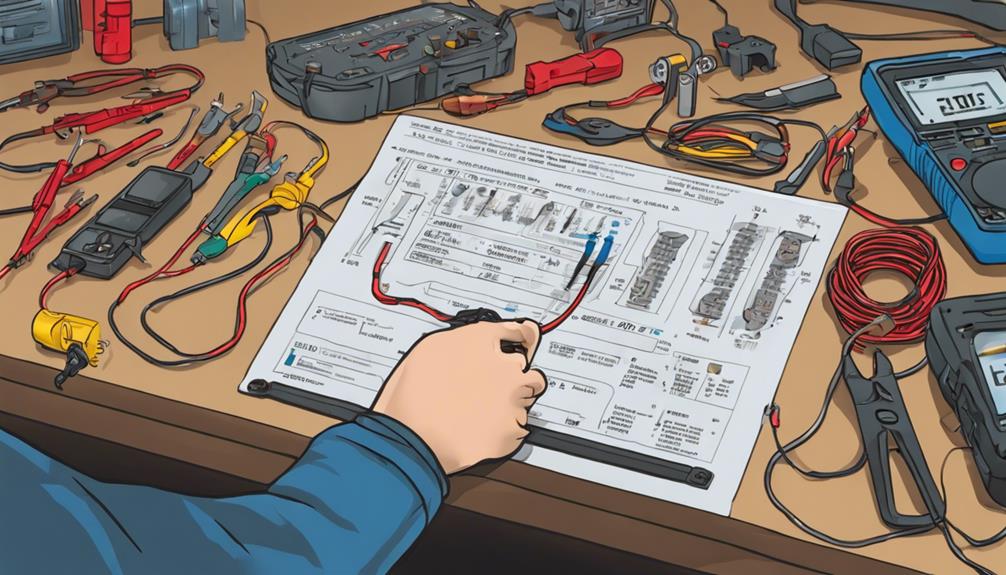
When testing and troubleshooting fuses in your car, utilize a fuse tester to determine functionality.
Look for signs of a blown fuse such as a broken filament or discoloration.
Ensure you replace any blown fuse with the exact same type and amperage to maintain proper electrical operation.
Fuse Functionality Testing
Inspecting fuses in your vehicle's fuse box with a fuse tester is crucial to identifying and resolving electrical issues efficiently. Make sure to follow these fuse functionality testing tips:
- Utilize a fuse tester to check for blown fuses accurately.
- Look for a broken filament inside the fuse to determine if it's blown.
- Replace blown fuses with ones of the same amperage rating to prevent further electrical problems.
Understanding these fuse testing techniques and troubleshooting common fuse problems will help you maintain a well-functioning electrical system in your car. Remember, properly functioning fuses play a vital role in safeguarding electrical circuits from overloading and potential damage.
Identifying Blown Fuses
If you're troubleshooting electrical issues in your car, one essential step is identifying blown fuses by using a fuse tester and inspecting the fuse box for any signs of damage.
Fuse troubleshooting involves checking for discolored or melted fuses, which indicate a fault. Specific components not working could also point to a blown fuse.
Utilize properly labeled fuse diagrams in the owner's manual to locate specific fuses for troubleshooting. Identifying electrical faults early can prevent further damage and ensure your car's electrical system functions properly.
Remember to replace blown fuses with the correct amperage rating to avoid future issues. Understanding how to identify blown fuses is crucial in maintaining your vehicle's electrical integrity.
Fuse Replacement Process
To effectively replace blown fuses in your car's electrical system, utilize a fuse tester to identify faulty fuses within the fuse box. When conducting the fuse replacement process, follow these key techniques and safety precautions:
- Inspect the fuse for any visible break in the metal wire inside to determine if it's blown.
- Replace a blown fuse with one of the same amperage rating to ensure proper functioning.
- Troubleshoot electrical issues by systematically checking and replacing fuses if needed.
Remember to adhere to proper fuse disposal methods to minimize environmental impact. Regularly inspect and replace fuses to maintain a well-functioning electrical system in your vehicle.
Mastering Battery Maintenance Techniques
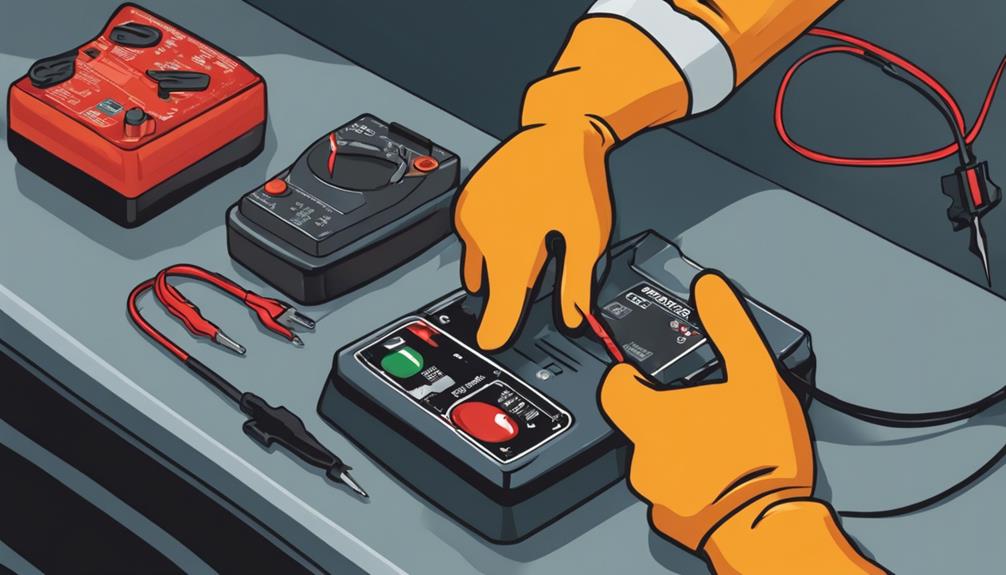
Regularly monitoring the battery fluid levels is crucial for maintaining optimal performance and longevity of your car's electrical system. To ensure your battery stays in top condition, follow these expert tips:
Battery Maintenance Techniques
| Maintenance Tip | Description | Benefits |
|---|---|---|
| Check Fluid Levels | Monitor electrolyte levels and top up with distilled water if necessary. | Prevents damage from low electrolyte levels. |
| Use Battery Tester | Regularly check voltage to detect any early signs of battery issues. | Helps prevent unexpected battery failures. |
| Clean Terminals | Remove corrosion from terminals using a mixture of baking soda and water. | Ensures a strong connection for efficient power. |
Diagnosing Alternator Issues Effectively
Mastering battery maintenance techniques ensures your car's electrical system operates efficiently, but diagnosing alternator issues effectively is equally crucial for preventing potential breakdowns and malfunctions.
To tackle alternator problems adeptly, focus on the following:
- Voltage Testing: A healthy alternator should output 13.5-14.5 volts when tested with a multimeter. Deviations from this range can indicate potential issues with the alternator's performance.
- Observing Symptoms: Keep an eye out for signs such as dim lights, battery problems, flickering dashboard lights, or a dead battery. These can be indications of a failing alternator that requires attention.
- Timely Replacement: Alternators play a vital role in charging the battery and powering electrical components while the engine is running. If you suspect alternator problems, prompt replacement is essential to prevent further electrical system complications and potential car breakdowns.
Addressing Common Starter Motor Problems
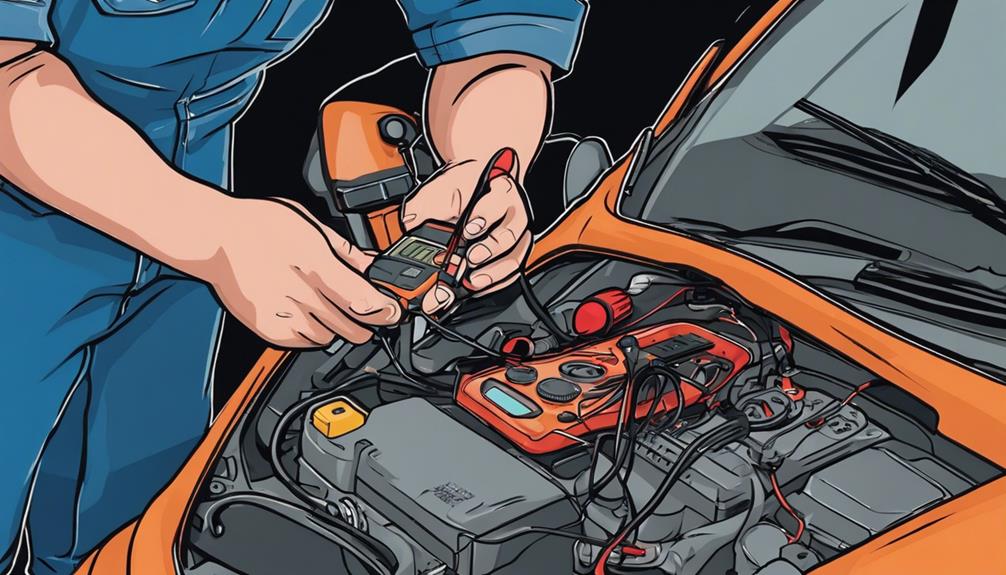
When experiencing starter motor problems, pay attention to the clicking sound, weak cranking noise, and potential electrical connection issues. These signs can indicate issues with the starter motor that may prevent your engine from starting.
Promptly addressing these problems is crucial to avoid further complications and ensure the smooth operation of your vehicle.
Starter Motor Clicking
If you hear a clicking sound coming from your starter motor, it's likely indicating a faulty or damaged starter that may require immediate attention.
When faced with starter motor clicking issues, consider the following:
- Check Electrical Connections: Ensure all connections to the starter motor are tight and free of corrosion.
- Test the Battery: A weak or discharged battery can cause starter motor clicking; check the battery's voltage.
- Inspect the Starter Solenoid: The solenoid plays a crucial role in engaging the starter; inspect it for any signs of wear or malfunction.
Weak Cranking Sound
To address the common starter motor problems associated with a weak cranking sound, a thorough examination of the electrical components and mechanical parts is crucial. When troubleshooting starter motor issues, various factors like worn-out brushes, solenoid problems, or electrical faults should be considered. Proper starter motor diagnostics involve checking battery voltage and inspecting starter connections. If these checks reveal faults, starting system repairs or solutions may be necessary. Replacing a faulty starter motor is often the most effective way to restore proper engine cranking functionality. Expert auto electricians are well-equipped to efficiently diagnose and replace malfunctioning starter motors, ensuring your car starts reliably.
| Starter Motor Problems | Diagnostic Steps | Repair Solutions |
|---|---|---|
| Worn-out brushes | Check brush wear | Replace brushes |
| Solenoid issues | Test solenoid | Repair or replace |
| Electrical faults | Check connections | Repair wiring |
Electrical Connection Issues
Examining the electrical connections is crucial in diagnosing and resolving common starter motor problems related to electrical issues. When troubleshooting battery drains and fixing loose connections, consider these essential steps:
- Check for corrosion or rust on the terminals and cables that may hinder the flow of electricity.
- Inspect the wiring harness for any signs of wear or damage that could disrupt the current to the starter motor.
- Ensure all connections are tight and secure to prevent intermittent power supply issues that may affect the starter motor's performance.
Dealing With Faulty Ignition Switches
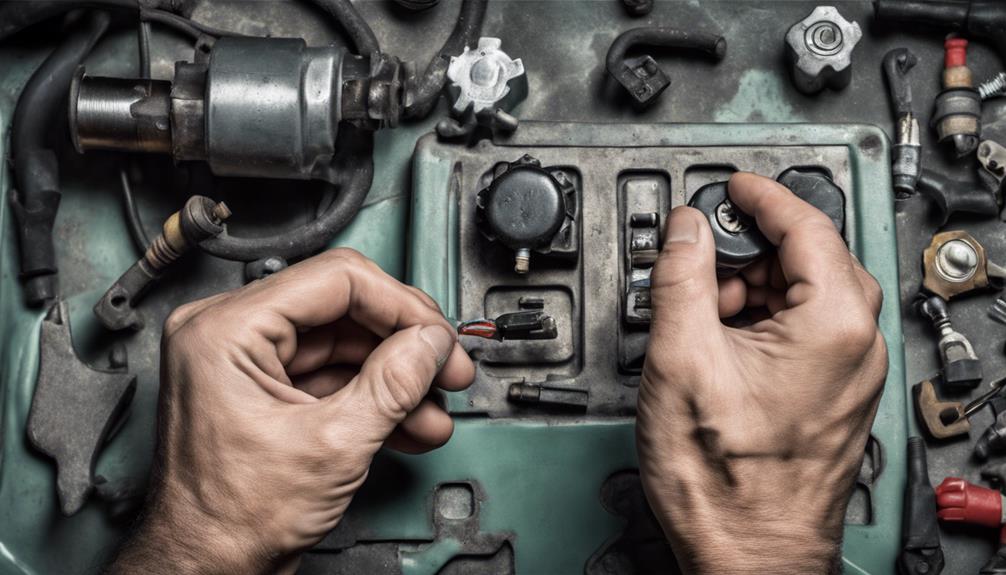
When diagnosing and addressing faulty ignition switches in your vehicle, it is crucial to understand the potential symptoms and causes for effective resolution. Ignition switch troubleshooting and maintenance are essential to ensure your car starts reliably. Here's a table to help you understand more about dealing with faulty ignition switches:
| Symptoms | Causes | Action |
|---|---|---|
| Stalling or power loss | Wear and tear | Professional diagnosis |
| Intermittent starting problems | Electrical issues | Timely replacement |
| Engine cutting out unexpectedly | Internal mechanical faults | Ensure safe and reliable operation |
| Engine not turning over |
Knowing How to Test Spark Plugs
Testing spark plugs is an essential procedure to ensure the proper functioning of your vehicle's ignition system. To effectively test spark plugs, follow these spark plug troubleshooting techniques:
- Utilize a spark plug tester: Use this tool to check for consistent sparks across all cylinders, ensuring each spark plug is functioning correctly.
- Look for weak or inconsistent sparks: A weak spark indicates a faulty spark plug that needs immediate replacement to maintain optimal engine performance.
- Clean carbon buildup: Periodically inspect and clean spark plugs to remove any carbon buildup that can hinder performance.
Understanding these ignition system diagnosis strategies is crucial for maintaining your vehicle's efficiency and performance. Remember, properly gapped spark plugs are vital for optimal engine function and fuel efficiency. By following these steps, you can ensure your spark plugs are in top condition, contributing to a well-maintained ignition system.
Handling Electrical Grounding Problems
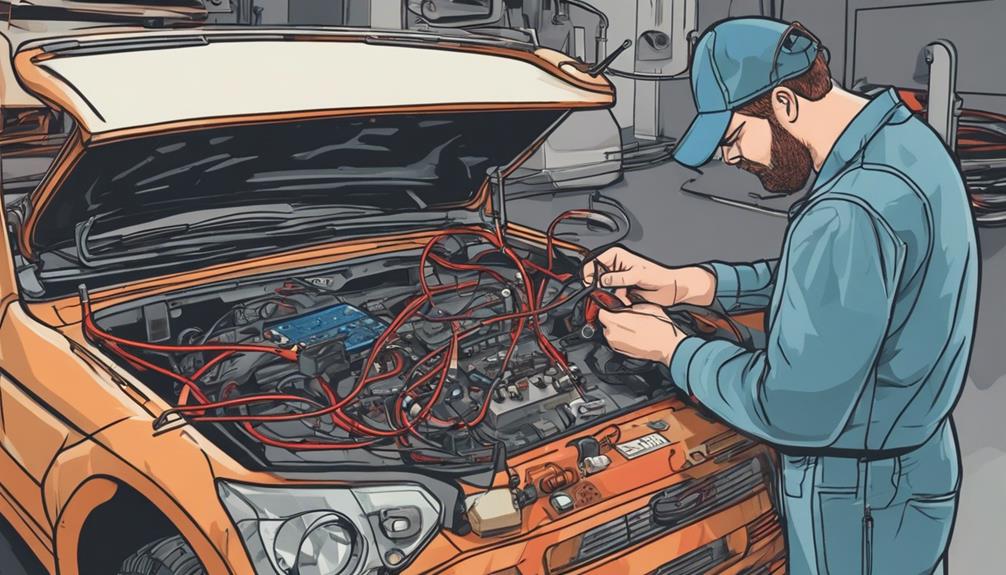
To address potential electrical issues beyond spark plug testing, understanding and addressing grounding problems in your vehicle is paramount for ensuring optimal performance and safety. Poor grounding can lead to malfunctions and safety hazards in cars, presenting symptoms such as flickering lights, erratic behavior in electronic components, and electrical shorts. Proper grounding techniques ensure efficient power distribution and prevent damage to sensitive electronic components. When troubleshooting grounding issues, look out for common signs like dimming headlights, radio interference, and problems with electronic accessories. Installing grounding wires correctly is crucial; below are some installation tips to aid you in this process:
| Grounding Techniques | Troubleshooting |
|---|---|
| Check for corrosion on grounding points | Test for continuity along the ground path |
| Use dedicated grounding points | Inspect ground straps for wear and tear |
| Ensure tight connections | Look for loose or damaged ground wires |
| Employ star washers for better contact | Verify ground connections with a multimeter |
| Consider adding extra grounding points | Seek professional help if issues persist |
Tips for Preventing Electrical System Failures
Wondering how to safeguard your vehicle's electrical system from potential failures? Here are some expert tips to help you prevent electrical system issues:
- Preventing corrosion buildup: Regularly inspect and clean battery terminals to prevent corrosion buildup, which can hinder the flow of electricity and lead to starting problems.
- Battery maintenance: Ensure your battery is securely mounted and free of any leaks. Regularly check the battery's electrolyte levels and top up with distilled water as needed to prolong its lifespan.
- Engine cranking, electrical system maintenance: Keep up with regular servicing and checks to prevent engine cranking problems. Clean the fuel injection system and throttle body to ensure smooth engine starts and reduce the risk of electrical issues.
Frequently Asked Questions
What Are the 10 Common Electrical Problems and Solutions?
Experiencing car electrical issues? Check for voltage fluctuations above 12 volts to resolve battery drain. Use a multimeter to test alternator output for 13.5-14.5 volts. Inspect fuses for failures and wiring for damage. Seek professional help if needed.
How Do You Trace Electrical Problems in a Car?
When tracing electrical problems in a car, start by testing battery voltage for fluctuations above 12 volts. Troubleshoot with a multimeter and look for signs of alternator issues like dim lights. Test alternator output for 13.5-14.5 volts.
What Is the Most Common Electrical Problem in a Car?
When your car's electrical system acts up, a common culprit is a dead battery. This issue can lead to battery drain, causing dim lights or failure to start. Another frequent problem to watch for is alternator issues.
What Draws the Most Current in a Car?
When you start your car, the starter motor demands the most current. High-power accessories like the AC or headlights also draw significant amps. Monitoring this is crucial to prevent battery drainage, alternator issues, and potential damage.
Conclusion
In conclusion, mastering car electrical problems is crucial for maintaining a well-functioning vehicle. By following expert tips and regularly inspecting and maintaining your car's electrical system, you can prevent costly damages and ensure a smooth driving experience.
Remember, the knowledge gained from this guide is like having a superpower that allows you to conquer any electrical issue with ease. Stay informed, stay proactive, and keep your car running smoothly for years to come.


